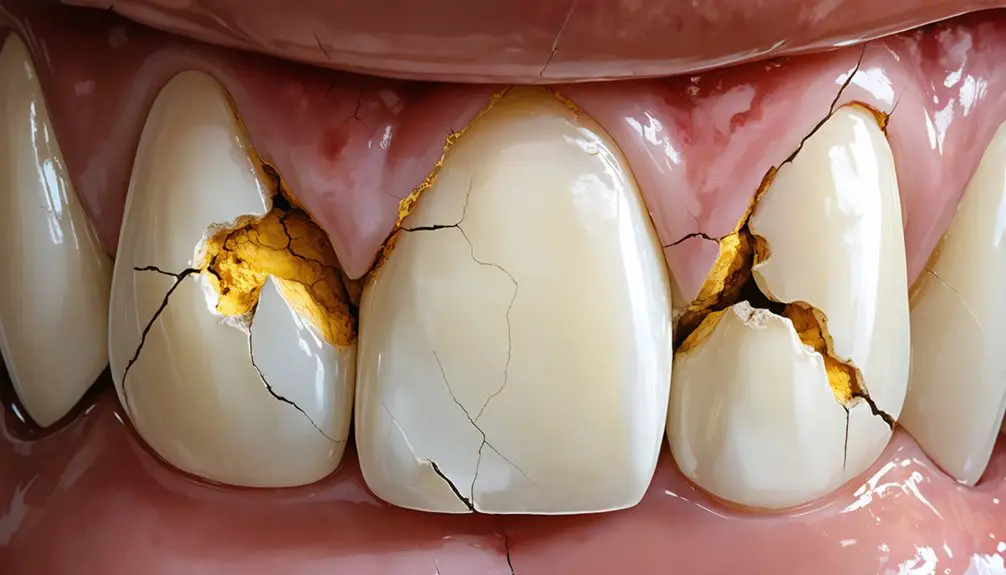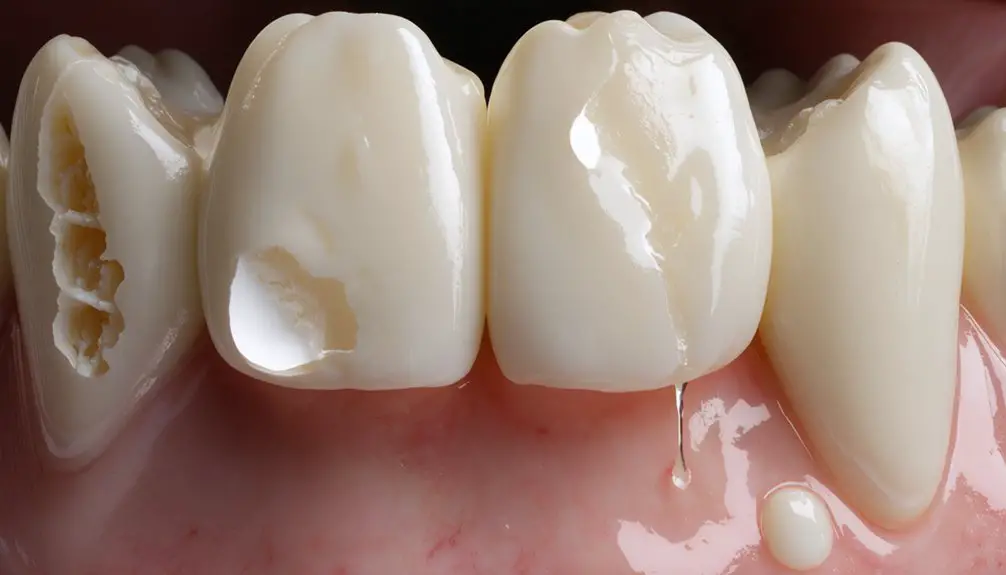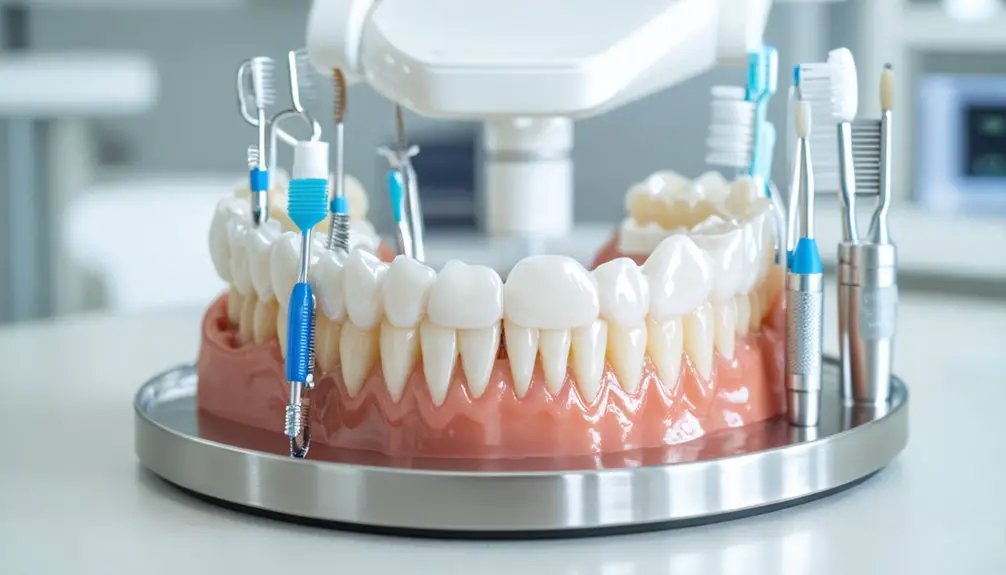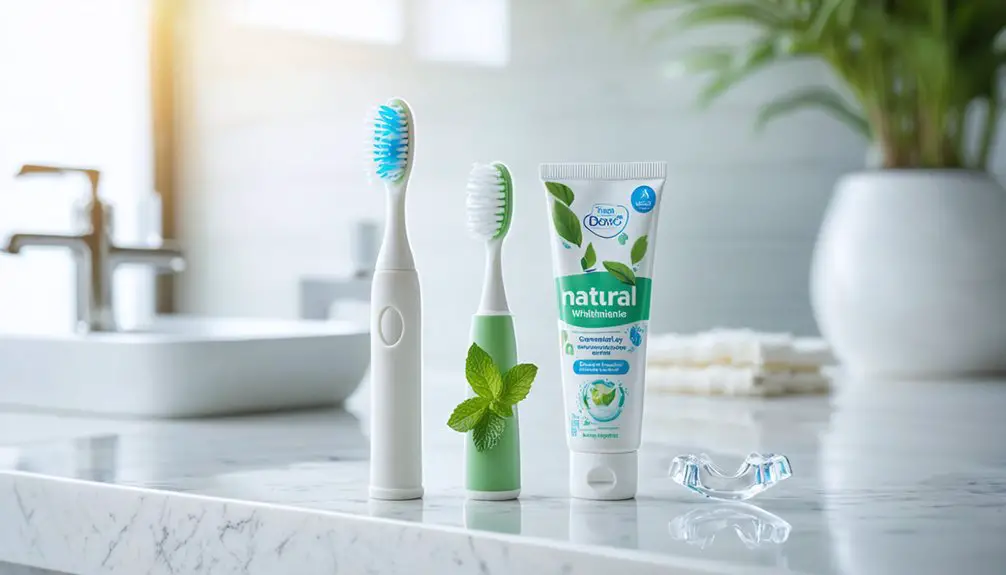While peroxide-based teeth whitening can be effective, you’ll face serious risks if used improperly. High concentrations can permanently damage your tooth enamel, cause severe sensitivity to hot and cold, and trigger gum inflammation or chemical burns. Over-the-counter products should contain no more than 3.5% hydrogen peroxide, and professional supervision is recommended for stronger treatments. Understanding proper application techniques and warning signs helps prevent lasting dental complications.
Key Takeaways
- Excessive peroxide exposure can permanently damage tooth enamel, leading to increased sensitivity and surface roughness that cannot be reversed.
- High concentrations of peroxide (above 33%) risk severe nerve damage and chemical burns to teeth and gums.
- Prolonged or improper use can cause gum inflammation, chemical burns, and white patches indicating tissue irritation.
- Uneven coloring may occur with dental restorations, while improper application can lead to infections and oral health complications.
- Up to 78% of patients experience tooth sensitivity during treatment, ranging from mild discomfort to severe pain.
Understanding How Peroxide Affects Your Teeth
When hydrogen peroxide comes into contact with your teeth, it initiates a complex chemical reaction that drives the whitening process. The peroxide chemistry involves H2O2 breaking down into water and oxygen, with the released oxygen molecules penetrating your tooth’s outer layers.
Hydrogen peroxide triggers a whitening reaction in teeth, decomposing into water and oxygen that penetrates enamel to break down stains.
These reactive oxygen particles then target and break down stain molecules within your enamel and dentin. This chemical process uses oxidation reactions to transform staining compounds into less pigmented molecules.
While enamel penetration allows peroxide to reach deep-set stains, it’s essential to understand the risks. Higher concentrations of peroxide can soften your enamel and increase tooth sensitivity. Professional supervision is crucial since ADA guidelines recommend using hydrogen peroxide under dental oversight.
The depth of penetration means whitening effects aren’t just superficial – peroxide actively changes the molecular structure of stain compounds inside your teeth. This process continues as long as the peroxide remains active, affected by factors like light, heat, and your saliva’s natural enzymes.
Common Side Effects of Teeth Whitening
When you undergo teeth whitening treatments, you’ll likely experience tooth sensitivity affecting between 30-78% of patients, with symptoms ranging from mild discomfort to severe pain as peroxide makes enamel more porous.
Your gums may become irritated and sore where the bleaching gel contacts oral soft tissues, particularly with at-home whitening kits due to improper application. A dentist consultation before starting any whitening treatment is vital as professional oversight helps minimize risks and ensures proper treatment selection. Dental restorations like crowns and veneers may result in uneven coloring since they don’t respond to whitening agents.
If you’re experiencing significant sensitivity or gum inflammation, you should consider discontinuing treatment, as approximately 13.8% of patients stop their whitening procedures due to these side effects.
Tooth Sensitivity Effects
Although teeth whitening procedures effectively brighten smiles, they frequently cause tooth sensitivity as their primary side effect, affecting between 30-78% of patients. The severity varies based on peroxide concentration, with higher concentrations (35-40%) causing more intense temporary discomfort than lower ones (10%). Research shows that 85.2 percent of patients experience some degree of sensitivity following whitening treatments.
For effective sensitivity management, you should know:
- Sensitivity peaks immediately after treatment and typically resolves within 24 hours, though some cases may last up to two weeks.
- You’ll feel heightened sensitivity to hot, cold, sweet, or acidic stimuli due to peroxide penetrating enamel and dentin.
- If you have pre-existing enamel wear or gum recession, you’re at higher risk for more intense sensitivity.
The good news is that sensitivity is temporary and reversible once the whitening agent is removed from your teeth. Studies show that choosing treatments with 10% carbamide peroxide can significantly reduce the risk of sensitivity while still achieving effective whitening results.
Gum Inflammation Concerns
Beyond tooth sensitivity, peroxide-based whitening treatments commonly trigger gum inflammation and chemical burns.
You’ll notice early warning signs like redness, swelling, and tenderness where the whitening gel contacts your gums. White patches resembling mild sunburns often indicate chemical irritation from peroxide exposure. Hydrogen peroxide agents in whitening products are the primary cause of gum irritation and burning sensations. Professional treatment options can significantly reduce these risks.
Your risk of gum inflammation increases considerably with improper application techniques, especially when using at-home whitening kits without professional guidance.
If you have naturally sensitive or thin gum tissue, you’re more susceptible to irritation. To protect your gum health, use protective barriers like dental dams or Vaseline around the gumline during treatment.
If you experience symptoms, stop whitening immediately and rinse with warm salt water. While most cases resolve within 24 hours, persistent inflammation requires professional evaluation.
The Risk of Permanent Enamel Damage
Despite its effectiveness for teeth whitening, hydrogen peroxide can pose considerable risks to your tooth enamel through prolonged or improper use.
When peroxide penetrates your enamel to reach the dentin beneath, it can trigger a process of enamel erosion if not properly controlled. The bleaching agent can also damage important collagen proteins in dentin tissue. Since enamel can’t regenerate naturally, any damage from peroxide misuse becomes permanent. Most at-home treatments use 3% concentration solutions mixed with water for safer whitening.
- Your enamel’s mineral structure weakens when exposed to high peroxide concentrations above 3% without professional supervision.
- You’ll notice increased tooth sensitivity and surface roughness as early warning signs of enamel damage.
- Your risk substantially increases if you whiten too frequently or combine treatments with acidic foods.
To protect your patients’ dental health, recommend professional whitening services and emphasize proper treatment intervals to prevent irreversible enamel deterioration.
Safe Concentration Levels and Application Times
You’ll need to carefully monitor both the concentration and application time when using hydrogen peroxide for teeth whitening, as exceeding safe levels can damage your teeth and gums.
For at-home use, stick to products containing 3-6% hydrogen peroxide and limit applications to 2-4 minutes daily when rinsing or 10 minutes when using fitted trays.
Professional treatments may use concentrations up to 40% but require strict supervision and controlled exposure times under a dentist’s care.
Peroxide Strength Guidelines
While peroxide concentrations vary considerably between dental whitening products, following recommended strength guidelines is essential for safe and effective treatment.
You’ll find different peroxide types and application methods across over-the-counter and professional treatments, each with specific safety thresholds established by regulatory authorities.
- Over-the-counter products should contain no more than 3.5% hydrogen peroxide or 10% carbamide peroxide to minimize risks of gum irritation and tooth sensitivity.
- Professional take-home kits typically use 10% carbamide peroxide (≈3.6% hydrogen peroxide) under dental supervision.
- In-office treatments may reach 35-40% concentration but require professional application with proper gingival protection.
Remember that European regulations are more conservative, limiting peroxide content to 0.1% in oral hygiene products, while US guidelines allow higher concentrations under appropriate supervision.
Safe Application Duration
Successful teeth whitening requires strict adherence to recommended application durations based on peroxide concentration levels.
For at-home treatments, you’ll need to limit initial sessions to 30-60 minutes, while professional treatments using 35% hydrogen peroxide shouldn’t exceed 15-30 minutes per session.
Watch your application frequency carefully – don’t exceed 7-14 sessions annually.
You must allow sufficient rest periods between applications to prevent enamel erosion and gum irritation.
Wait at least 24 hours between home treatments, and limit professional sessions to 1-2 times yearly.
Duration limits vary by concentration – higher strength products require shorter application times, while lower concentrations can be used longer.
Always start with shorter durations to assess sensitivity before gradually increasing treatment time if no adverse effects occur.
When Teeth Whitening Becomes Dangerous

Although teeth whitening treatments are generally safe when used as directed, improper application or excessive use of peroxide-based products can lead to serious dental complications.
While teeth whitening is typically safe with proper use, misusing peroxide products risks severe damage to your dental health.
Your tooth enamel can become permanently damaged when exposed to high concentrations of peroxide, especially in acidic conditions. These peroxide interactions can cause significant changes to your enamel’s microstructure, making teeth more susceptible to decay and sensitivity.
- Using products with hydrogen peroxide concentrations above 33% can cause severe nerve damage, burns, and irreversible pulpal inflammation.
- Unregulated DIY whitening kits may contain dangerous chemical levels that risk mouth infections and tissue damage.
- Excessive bleaching can dehydrate teeth, leading to temporary whitening but compromising long-term tooth integrity.
Protecting Your Oral Health During Whitening
To protect your oral health during teeth whitening treatments, you’ll need to follow specific safety protocols and guidelines designed to minimize risks while maximizing results.
Maintain diligent oral hygiene practices but use gentle brushing techniques to avoid aggravating sensitive teeth and gums. Consider alternative whitening methods if you experience persistent sensitivity, and always consult your dentist before starting any whitening regimen.
Key oral care tips include limiting peroxide contact time to no more than 1-2 minutes, using products with 3-6% concentration, and avoiding treatment more than once daily.
Use fluoride-containing products to help remineralize enamel, and steer clear of extremely hot, cold, or acidic foods during treatment. If you notice prolonged sensitivity or gum irritation, discontinue use and seek professional guidance immediately.
Signs You Should Stop Using Peroxide

Recognizing when to discontinue peroxide-based teeth whitening is essential for protecting your oral health and preventing lasting damage. Proper sensitivity management and gum care require you to monitor your body’s response to treatment carefully.
- Stop immediately if you experience persistent tooth sensitivity to hot, cold, or sweet stimuli, as this indicates potential exposure of your tooth’s dentin layer.
- Cease use when you notice gum inflammation, redness, or bleeding, particularly if you have pre-existing periodontal conditions.
- Discontinue treatment if you develop any oral lesions, burns, or unusual white patches, or if your teeth become unnaturally translucent.
Don’t attempt to push through discomfort by using desensitizing products. Instead, consult your dental professional if you experience severe or lasting symptoms after stopping peroxide use.
Professional Guidance for Safe Teeth Whitening
While over-the-counter whitening products carry risks, professional dental supervision provides a safer, more controlled approach to teeth whitening. Through professional consultation, you’ll receive a thorough oral health assessment before treatment begins, ensuring your teeth and gums are suitable for whitening procedures.
Dentists use medical-grade peroxide concentrations of 25-40%, applied with precision using customized trays and protective barriers. They’ll monitor your treatment closely, adjusting protocols based on your sensitivity levels and response.
Advanced technologies like LED or laser activation enhance safety while delivering superior results, often achieving up to eight shades lighter in one session. Safe practices include following post-treatment care instructions and scheduled follow-ups.
Your dentist will provide maintenance guidelines and may recommend take-home trays with lower peroxide concentrations for touch-ups under continued supervision.
Frequently Asked Questions
Can Pregnant or Nursing Mothers Safely Use Peroxide-Based Teeth Whitening Products?
You shouldn’t use peroxide whitening while pregnant or nursing, as safety guidelines recommend avoiding these treatments. Instead, consider alternative options like peroxide-free toothpaste or wait until after pregnancy.
How Long Should I Wait Between Professional Whitening Treatments?
You should wait 6 months to 1 year between professional whitening treatments. This treatment interval allows proper enamel recovery, while whitening frequency that’s too high risks sensitivity and damage.
Does Teeth Whitening With Peroxide Affect Existing Dental Work or Crowns?
Like a chameleon meeting its match, your dental restorations won’t change color with peroxide whitening. You’ll notice peroxide effects mainly impact natural teeth, potentially causing mismatched shades with existing crowns.
Will Tooth Sensitivity From Whitening Affect My Ability to Get Dental Work?
While you’ll need to wait for temporary tooth sensitivity to subside, it won’t permanently affect your ability to receive dental procedures. Most sensitivity resolves within days to weeks.
Can Children or Teenagers Safely Use Peroxide Whitening Products?
You shouldn’t use peroxide whitening products before age 12-13 due to significant safety concerns. Your child’s thin enamel and developing teeth face increased risks of sensitivity, damage, and mineral loss from whitening treatments.
References
- https://www.healthline.com/health/hydrogen-peroxide-teeth-whitening
- https://www.medicalnewstoday.com/articles/326148
- https://ec.europa.eu/health/scientific_committees/opinions_layman/en/tooth-whiteners/l-3/5-tooth-whitening-products.htm
- https://pubmed.ncbi.nlm.nih.gov/23846062/
- https://www.gentledental.com/resources/articles/hydrogen-peroxide-teeth-whitening
- https://www.hollywoodwhitening.com/en/blog/hydrogen-peroxide-for-teeth-whitening-how-does-it-work/
- https://pmc.ncbi.nlm.nih.gov/articles/PMC4058574/
- https://www.mcgill.ca/oss/article/health-you-asked/how-does-peroxide-whiten-teeth
- https://www.dentistryofwestbend.com/teeth-whitening-risks-and-side-effects/
- https://harborcreekdental.com/side-effects-of-teeth-whitening/



